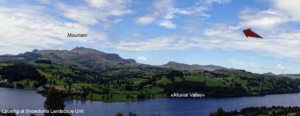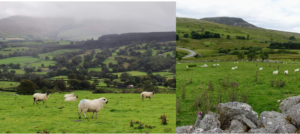This blog was written for the RSA Blog Student Summer Series that will highlight graduate student success in regional studies across the globe throughout the summer.
Studying the farming history in the UK I realised there had been inflexion points where farming’s fortunes have changed dramatically. For example, the 1920’s agricultural crisis (for the worse) or the 2nd World War (for the better). Farming has been consistently supported throughout the last 70 years, but this support is set to evolve dramatically shifting away from a model favouring farm output and farm size. The Farm Business Surveys show how fragile the average farm is, we will try to understand the narrative behind it.
I will base myself on a 6 month long multi-disciplinary agrarian diagnosis (Cochet, 2011) that I conducted during 2020 in the Upper Dee Vale around Bala (Cymru, Wales).

Figure 1 – Upland organization from the valley to the Mountain 3 distinct steps on Snowdonia landscape unit, a mosaic landscape (July 2020, LT, East side of Llyn Tegid)
A mosaic inside a mosaic with different production potentials
It starts with the location of the farm, farming is not run by dates but by the climate and how it interacts with the local environment. Around Bala I encountered 3 different landscape units each featuring an alluvial valley, some hills and mountain land (See figure 1). Those different places feature different micro-climate, soil, relief, land use and management, a mosaic inside a mosaic, each with its production potential. You could summarize it as follows: the higher you go, the more you go towards the Snowdonia side, the more constrained and difficult the production potential (timewise, versatility, raw output, headroom, risk).

Figure 2 – 2 pictures taken in the study area, in the alluvial valley with its smooth hills bordered by hedges and on the mountain of Snowdonia. Different breeds of sheep, the ones in the valley are bigger, produce more lambs compared to the Welsh mountain ewes to the right, but they are more demanding.
Some, but not all, of those differences have been reduced by improvements in farming techniques with a focus on food output. The word “improvement” though imperfect has been used to cover the tools and inputs brought with the 20th century agricultural revolution or green revolution, including: motorization, use of bought-in inputs, etc. For more information see: Allen R.C. 1999 or Brassley P. 2000. In this way, farms specialized and differentiated, focusing on one food product with specialized equipment’s, inputs or animals breeds. This resulted in a change out of the previously mixed and self-sufficient farming systems. Overall, most specialised in beef and sheep due to the area diverse and sometimes difficult landscape.
The lush and “warm” alluvial valley could go for bigger sheep, bigger cattle, produce more from the land, fetch a higher remuneration. On the rocky and exposed Snowdonia mountain this was not a possibility. Despite innovations, small hardy sheep on rough grazing producing low-value light lambs were still the only workable system.
This move towards increased outputs was linked to a reorganisation of our food production system with a standardisation and a massification; food prices went down (When you remove factors linked to inflation, in real prices). The food produced was produced at higher health standards but it’s diversity was reduced, it was more and more seen as a swappable commodity. This change was not critical for farmers because they could grow bigger, could buy the tools and were supported to do so. Through increasing labour productivity this problem was solved temporarily.
A steep reduction in farm numbers as a result of successive income challenges
During times when farming support was “production focused”, the number of farms reduced faster on the difficult stretch of the landscape, despite subsidies towards least favoured areas to support those farms. From the 1990s as the support started to be curtailed, the hills and the valleys were hit harder. Indeed, this selection pressure had less effect on those holding mountain land as they could gradually benefit from new subsidies aimed at preserving environmental features.
Since that time farms’ incomes have continuously been under-pressure with rising inputs and machinery costs while agricultural product prices have remained at low levels. Among the options explored by farms:
- Many chose to retire.
- Some tried to add income sources, finding a part-time job or diversifying in tourism, electricity generation…
- Some farms went for a strategy based on volume and size, looking for both economies of scale and making the most of subsidy payments; with or without increased use of inputs; concentrating land and animals.
- Others differentiated their farming system to look for more rewarding productions; poultry farming, dairy farming, organic farming… Usually using increased amounts of input.
Each time the development had to be accessible and compatible with the rest of the farming system. Thus, in and around farming we observe more activities and more assets than ever being dealt with by fewer women and men, larger amounts of land to manage, longer and lonelier days. Farming in Bala is constrained with many farms selling what are considered as low-valued commodities (wrongly for some of them according to my experience) and heavily reliant on subsidies. Only few opportunities exist to try to differentiate the retail side.
The future support system wants to achieve a sustainable future for Welsh farming. It will notably have to halt the disappearance of would-be land stewards and to give them time to manage the land and ecosystems. Many threats to farming and landscapes sustainability are enshrined in the global agri-food supply chain, focusing on farms alone risk to only tweak the trends witnessed over the past decades. The challenge is to integrate the different facets of sustainability to create a fairer scheme that helps farming transform to deal with more challenges than ever before. Nevertheless we are at an inflexion point.

Théo Lenormand (Twitter: @to_lnr and Personal Website) is a PhD Candidate at the Countryside and Community Research Institute at the University of Gloucestershire. His PhD examines the landscape and the impact at a community level, including from an economic perspective, of the post-Brexit environment (policy and trade) on the Welsh farm’s choice of evolution.
Disclosure: This research has been partly funded by the Welsh government through the Environmental Evidence Programme. Other funders of my PhD are the Countryside and Community Fund and the University of Gloucestershire. The views expressed below are my personal thoughts and do not reflect those of my supervisors, research institute or sponsors. Thanks to Chris Short and prof. Janet Dwyer my supervisors for reviewing the language of this article.
Are you currently involved with regional research, policy, and development? The Regional Studies Association is accepting articles for their online blog. For more information, contact the Blog Editor at rsablog@regionalstudies.org.